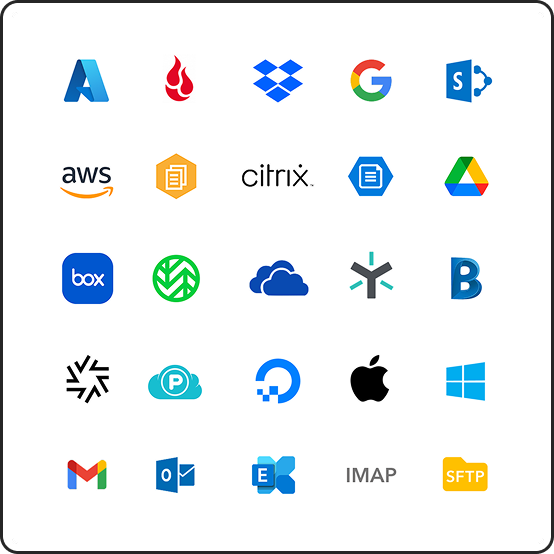A typical worker receives about 120 email messages a day. Even assuming as much as 75% of those are spam or never get opened, that’s over 10,000 emails per person per year. That’s a lot of emails. While there’s a good chance most of those aren’t needed, it’s still understandable to want to move those emails during a migration. But how many people really need emails from 12 years ago cluttering their Inbox? There might be a couple of super important emails in there, so most email migration tools pull everything over, important or not.
Movebot does it different.
We’ve taken the traditional method of email moving, flipped it, and given it the boot, creating a better way to move emails, not just to other mail servers, but anywhere you want.

Users to user — or different User
Typically, an email migration tool will take the data from one user, then port everything over to a new user on the new system, like taking Jimothy’s Google Workspace Email account and moving that to a new Jimothy account in Outlook. For a lot of cases, this is fine. But what if Jimothy only wants some of the emails? Or what if they were let go but the emails are still important to keep?
That’s where Movebot’s filtering and exclusion system comes in.
Moving and filtering mailboxes
So you have some emails you want to move, but not all. This is where the magic of Movebot appears. Unlike other email migration tools, Movebot doesn’t make you move entire users and all their data. Once you connect the accounts, you can move everything, or you can only include emails that match certain criteria or exclude emails the same way. Keep in mind that Movebot doesn't do any filtering automatically; you need to specify what you want to include or exclude, which gives you maximum control over what actually gets moved.
But filtering isn't all Movebot can do. Movebot takes it a step further by letting you move emails between inbox folders and even different users. For instance, suppose Jimothy uses a Cool Memes label in their Gmail account and wants to make sure those get saved to a special place in Microsoft. With Movebot, you can make a Cool Memes folder in Outlook, take everything in that label in Gmail, and move it to that folder in one transfer. Then, you can create another transfer to move the rest of the emails to a primary inbox.
And that’s only the start. That Important folder could be moved to an entirely different User, while Cool Memes could be left behind or moved to yet another User. You can break down a User’s emails by whatever criteria you want, and move those specific emails to whatever other User you want, including in the same tenant. You have full control of your data.

Okay, so what about emails you don’t want to go to a user but might need someday for something like compliance? Don’t worry, Movebot has a solution for those too.
Move emails anywhere
When most people hear about “migrating emails”, they’ll assume it means moving emails from one email provider to another. That’s because up until now, that was really the only option.
Movebot’s always believed in giving you maximum control of your data, and that extends to emails too. Movebot supports over 30 storage platforms, and you can move your emails to any one of them. Sure, that includes Email to Email. Emails to Dropbox? Yep. Emails to Wasabi? Of course.
EML files
So how does it work? How is it possible to move an email to a storage platform? The magic is in how Movebot processes emails. In Movebot, whether you’re moving emails to another mail server or a storage platform, the file is stored as a .eml file, which is an email file that includes all the information about the email including the body, subject, sent time, and all other metadata. All major cloud platforms support saving .eml files, and there are many applications that can open them.
This opens up a whole new method of data lifecycle management. Those 12-year-old emails you may or may not need one day don’t have to sit in an Inbox anymore. They can be backed up to cloud storage, including archival storage, where you can keep them if and when you need them.
So what happens if you do need those emails?
Restoring emails
Those .eml files don’t have to stay in that format permanently. You can open the email with several applications to view the contents. But you can also use Movebot to send that email file back to the email account. When in an email client, the EML file will behave like a typical email with all the existing metadata attached, so it will be like it never left.
With filtering and the ability to break down transfers at a granular level, that means you can move emails between different users with ease too. Need all the emails from your CEO for a user whose profile you’re going to delete? Isolate by sender and only include those emails in your transfer, then send them to a new user and they’ll appear like magic.
Move, backup, and restore emails whenever you want.
Transfer-based pricing
Because of the way other email migration tools are designed, each User acts as a distinct chunk that is moved as one piece. As a result, you pay for each user migrated to the new mail provider. This can work great when you have a lot of active users with a low amounts of data. But what about if you have several larger accounts"
Movebot is all about moving data, and that’s how we charge too. Emails are charged just like any other type of data, by number of transfers. Pay only for the data you move at the transfer level.
Contacts and Calendars also supported
Moving emails anywhere is great. But Movebot can do the same thing with contacts and calendars. Like with emails, calendars, and contacts are converted into a default file format, JSON and CSV respectively. And since all of the major cloud storage providers support both of these formats, you can move contacts and calendars to any supported storage, just like emails.
Move entire mailboxes into the cloud. Split up emails into a separate folder. Move only contacts. The choice is yours with Movebot.
Try moving mailboxes a better way with Movebot
Whether you want to do a simple email to email migration or have something extravagant in mind with moving emails, contacts, and calendars to any of the 30+ platforms that Movebot supports, migrations are fast, straightforward, and affordable. With per-transfer pricing and full control of where your data goes, there’s a better way to move mailboxes with Movebot.
Want to see how simple it is for yourself? Register for an account and explore Movebot with no credit card required. Simply sign up, connect your storage, and see how easy migrations can be. Register for an account now to get started.







